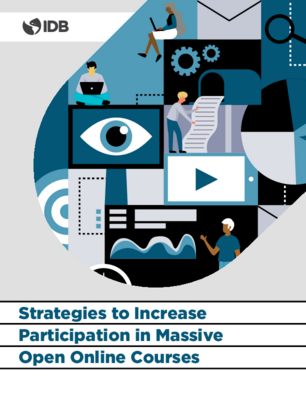Strategies to Increase Participation in Massive Open Online Courses
Date
Oct 2021
In this document we will explain how, over the years, the Inter-American Development Bank has been implementing strategies to encourage Bank audiences to engage in and take advantage of its Massive Open Online Courses (MOOC).
MOOC are very powerful learning tools because they are open courses that, in most cases, can be taken at a students own pace, thus making them ideal for people with busy lives. They also have a broad scope, since they can provide training to thousands of people at the same time at a low cost per participant. However, MOOC also have certain limitations, such as the need for suitable devices; access to high-quality internet; or limited access to certificates, which usually have to be paid for. Another big challenge that we encounter regarding MOOC is that, as they are open and free of charge, a high percentage of registrants who enroll in a course do not take it.
This document analyzes the evolution of engagement indicators, i.e., students commitment to a course. It also measures the success of the IDBs MOOC in maintaining students in courses. Moreover, the document describes the different strategies that we have implemented over time to ensure that people who register for these courses actually take advantage of them. Even though engagement has been a concern throughout the history of the IDBx Program and actions have been taken to maintain participation at stable levels, since 2019, a greater effort has been made to understand the reasons why registrants did not ultimately participate in the courses, so as to devise strategies to mitigate that behavior in our audience.
MOOC are very powerful learning tools because they are open courses that, in most cases, can be taken at a students own pace, thus making them ideal for people with busy lives. They also have a broad scope, since they can provide training to thousands of people at the same time at a low cost per participant. However, MOOC also have certain limitations, such as the need for suitable devices; access to high-quality internet; or limited access to certificates, which usually have to be paid for. Another big challenge that we encounter regarding MOOC is that, as they are open and free of charge, a high percentage of registrants who enroll in a course do not take it.
This document analyzes the evolution of engagement indicators, i.e., students commitment to a course. It also measures the success of the IDBs MOOC in maintaining students in courses. Moreover, the document describes the different strategies that we have implemented over time to ensure that people who register for these courses actually take advantage of them. Even though engagement has been a concern throughout the history of the IDBx Program and actions have been taken to maintain participation at stable levels, since 2019, a greater effort has been made to understand the reasons why registrants did not ultimately participate in the courses, so as to devise strategies to mitigate that behavior in our audience.




